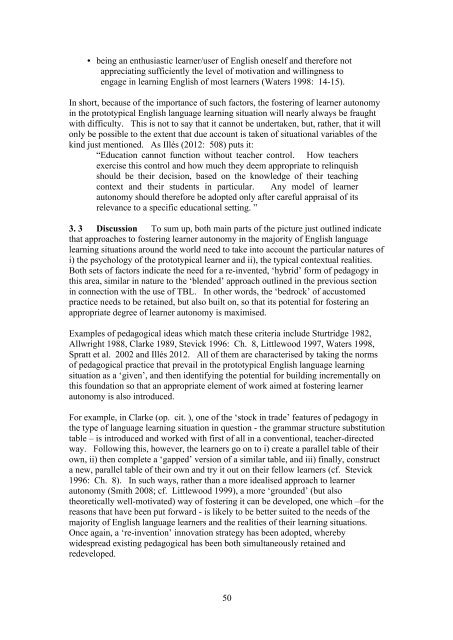RADICAL TEFL
2hqhXJd
2hqhXJd
You also want an ePaper? Increase the reach of your titles
YUMPU automatically turns print PDFs into web optimized ePapers that Google loves.
• being an enthusiastic learner/user of English oneself and therefore not<br />
appreciating sufficiently the level of motivation and willingness to<br />
engage in learning English of most learners (Waters 1998: 14-15).<br />
In short, because of the importance of such factors, the fostering of learner autonomy<br />
in the prototypical English language learning situation will nearly always be fraught<br />
with difficulty. This is not to say that it cannot be undertaken, but, rather, that it will<br />
only be possible to the extent that due account is taken of situational variables of the<br />
kind just mentioned. As Illés (2012: 508) puts it:<br />
“Education cannot function without teacher control. How teachers<br />
exercise this control and how much they deem appropriate to relinquish<br />
should be their decision, based on the knowledge of their teaching<br />
context and their students in particular. Any model of learner<br />
autonomy should therefore be adopted only after careful appraisal of its<br />
relevance to a specific educational setting. ”<br />
3. 3 Discussion To sum up, both main parts of the picture just outlined indicate<br />
that approaches to fostering learner autonomy in the majority of English language<br />
learning situations around the world need to take into account the particular natures of<br />
i) the psychology of the prototypical learner and ii), the typical contextual realities.<br />
Both sets of factors indicate the need for a re-invented, ‘hybrid’ form of pedagogy in<br />
this area, similar in nature to the ‘blended’ approach outlined in the previous section<br />
in connection with the use of TBL. In other words, the ‘bedrock’ of accustomed<br />
practice needs to be retained, but also built on, so that its potential for fostering an<br />
appropriate degree of learner autonomy is maximised.<br />
Examples of pedagogical ideas which match these criteria include Sturtridge 1982,<br />
Allwright 1988, Clarke 1989, Stevick 1996: Ch. 8, Littlewood 1997, Waters 1998,<br />
Spratt et al. 2002 and Illés 2012. All of them are characterised by taking the norms<br />
of pedagogical practice that prevail in the prototypical English language learning<br />
situation as a ‘given’, and then identifying the potential for building incrementally on<br />
this foundation so that an appropriate element of work aimed at fostering learner<br />
autonomy is also introduced.<br />
For example, in Clarke (op. cit. ), one of the ‘stock in trade’ features of pedagogy in<br />
the type of language learning situation in question - the grammar structure substitution<br />
table – is introduced and worked with first of all in a conventional, teacher-directed<br />
way. Following this, however, the learners go on to i) create a parallel table of their<br />
own, ii) then complete a ‘gapped’ version of a similar table, and iii) finally, construct<br />
a new, parallel table of their own and try it out on their fellow learners (cf. Stevick<br />
1996: Ch. 8). In such ways, rather than a more idealised approach to learner<br />
autonomy (Smith 2008; cf. Littlewood 1999), a more ‘grounded’ (but also<br />
theoretically well-motivated) way of fostering it can be developed, one which –for the<br />
reasons that have been put forward - is likely to be better suited to the needs of the<br />
majority of English language learners and the realities of their learning situations.<br />
Once again, a ‘re-invention’ innovation strategy has been adopted, whereby<br />
widespread existing pedagogical has been both simultaneously retained and<br />
redeveloped.<br />
50


